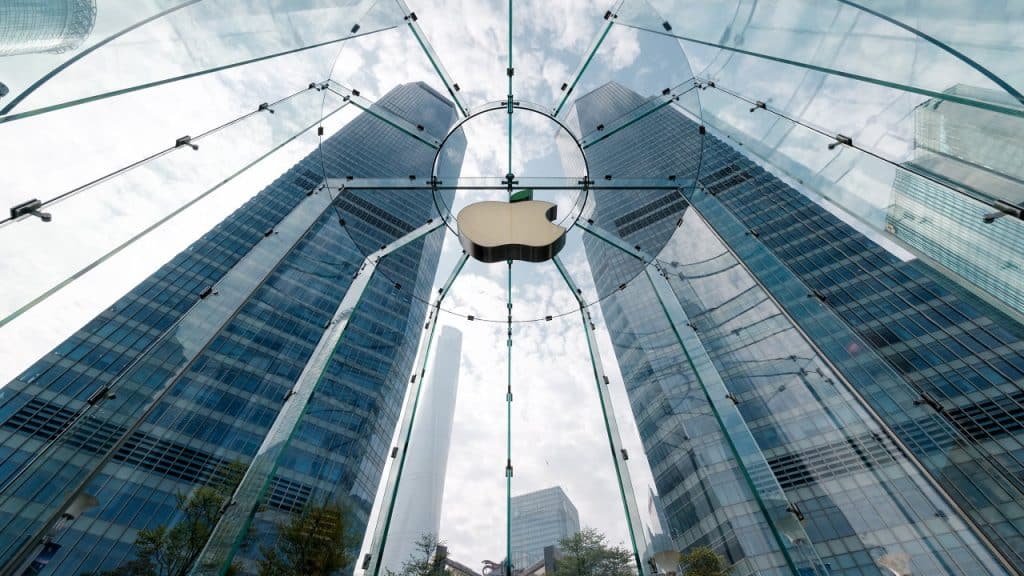This Thursday (27/10), Apple presented the financial report for the fourth fiscal quarter of 2022 (Q4 FY 2022), a period that corresponded to the third calendar quarter of this year, covering the months of July to September. Unsurprisingly, Apple of Cupertino continues to be a giant and healthy company, with a growth trend in Asia.
The beautiful glass roof of an Apple store in Asia (credit: Wiki Voyage) Let’s get to the global numbers: APPLE FINANCIAL REPORT Period → Q4 FY 2021
(July to September 2021) Q4 FY 2022
(July to September 2022) Difference Revenue US$ 83.36 billion US$ 90.15 billion + 8.14% Profit US$ 20.55 billion US$ 20.72 billion + 0.83% Above we have an overview of the Apple of Cupertino, with the company’s key financials for the three months ending September 24, 2022. Uncle Laguna wonders when they’re going to correct absent days to coincide with the calendar quarter (I know). Anyway, we see a nice 8.14% increase in revenue over Q4 FY 2021 and a slight 0.83% growth in quarterly earnings, which totaled $20.72 billion in Q4 FY 2022. profit of US$ 227.7 million per day, coming from an average global daily revenue of almost 1 billion dollars (US$ 990.62 million per day) in the 13 weeks that make up the disclosed period! Who’s responsible for Apple’s beautiful $90.15 billion in fiscal fourth quarter revenue? To try to understand the composition of this almost billion daily raised, let’s see how much each main line of Apple products raised: SUMMARY OF APPLE REVENUES Period → Revenue
Q4 FY 2021 Revenue
Q4 FY 2022 difference
about
Q4 FY 2021 iPhone $38.87 billion $42.63 billion + 9.67% Mac $9.18 billion $11.51 billion + 25.39% iPad $8.25 billion $7, 17 billion – 13.06% wearables and accessories US$ 8.79 billion US$ 9.65 billion + 9.85% subscriptions US$ 18.28 billion US$ 19.19 billion + 4.98% Revenue US$ 83, 36 billion US$ 90.15 billion + 8.14% Just as Microsoft “hides” the Xbox Series X|S numbers, Apple prefers not to reveal how many units it has sold of each hardware, including the star iPhone. As such, we can only speculate that although the recent iPhones 14 (and Plus/Pro/Max) were released into civilization from the 16th of September, these 9 days of sales failed to positively affect the quarter as a whole. In other years, this window of one to two weeks at the end with all the new models already available lifted the quarter thanks to the sale and pre-sale of the new smartphones. Although not the main star of revenue, the company’s notebooks achieved a significant growth of 25% in revenue in the segment thanks to the launch of MacBooks with the Apple M2 processor. Available on the civilized market since July 15th, we can say that the Q4 FY 2022 was positively affected by the new MacBooks, including in Asia.
Strong growth in Asia (except Japan)
APPLE’S REVENUES IN ASIA Period → Revenue
Q4 FY 2021 Revenue
Q4 FY 2022 difference
about
Q4 FY 2021 Mainland China US$14.56 billion US$15.47 billion + 6.23% Japan US$5.99 billion US$5.70 billion – 4.86% Mainland Rest US$5.19 billion US $6.37 billion + 22.75%
TOTAL:
US$ 25.75 billion US$ 27.54 billion + 6.98% global share 30.89% 30.55% – 1.07% Uncle Laguna usually focuses on Apple in Asia because there are two giants there, China and Japan, and a variety of heterogeneous markets when it comes to the Cupertino Apple. If Japan has been stagnant with a slight downward trend in the consumption of Apple products and services, in China we can see that there is room for expansion, but perhaps not as much as in the rest of the continent. There is a lot of room for Apple to grow on the Asian continent, so much so that we could see a 23% increase in revenue there in a quarter that is only fueled by the hype of the new iPhones. Unless countries like Saudi Arabia and India are buying more MacBooks M1 with the arrival of those with M2, there is only suspicion in the air. As the $2.32 trillion Apple no longer discloses unit sales data for its products, let alone how much they are selling in each region of the planet, we can only say that Apple is doing very well in China and the Asian market as almost a whole. Sources: 9 to 5 Mac, Bloomberg and CNBC.
